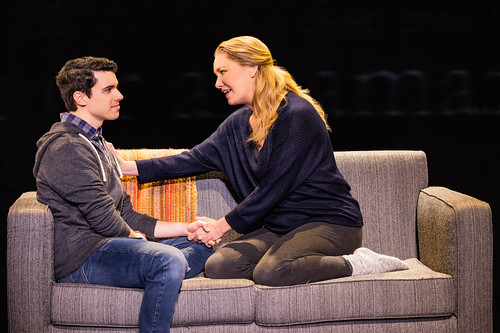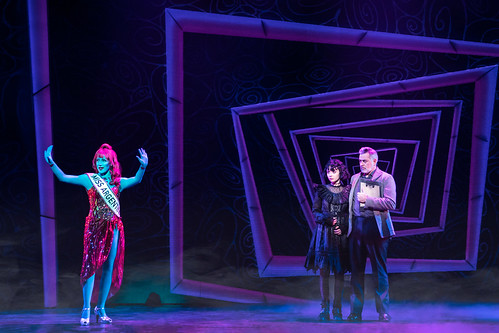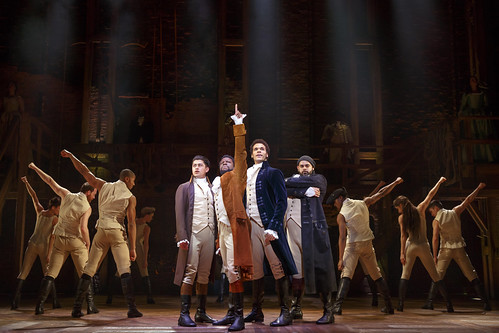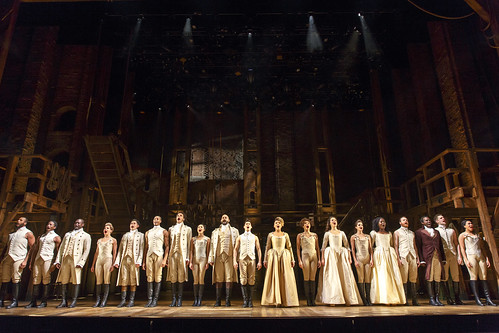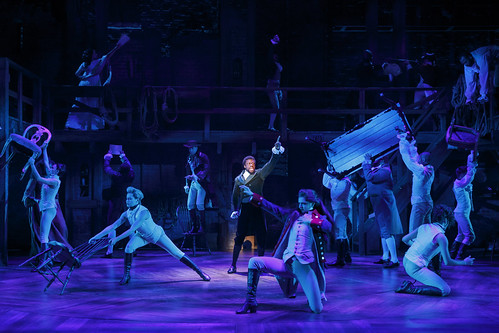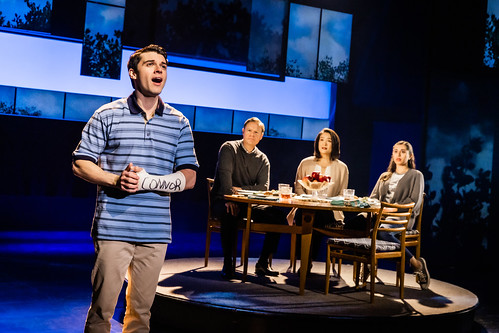
ABOVE: Anthony Norman (left) is Evan Hansen in the 2022-23 North American tour of Dear Evan Hansen. Also in the cast are (from left) John Hemphill as Larry Murphy, Lili Thomas as Cynthia Murphy and Alaina Anderson as Zoe Murphy. BELOW: Norman’s Evan attempts connection with his single mom played by Coleen Sexton. Photos by Evan Zimmerman for Murphymade
The movie version of Dear Evan Hansen broke more than its protagonist’s arm. It shattered its source material – a Tony Award-winning musical – into a million awful little pieces. The movie made the cardinal mistake of taking something that can be extraordinary in the theater and making it seem absolutely absurd when earnest characters started to sing in their living room or their classroom, and the audience response was to wince or, even worse, to laugh.
At the time of the movie’s release (fall of 2021) there was a lot of unnecessary gnashing about how original Broadway star (and Tony winner) Ben Platt was too old (27 at the time) to convincingly play a 17-year-old. Platt was hardly the problem. His Herculean stage performance was fairly effectively modulated for the screen. But it’s the very notion of this story on a screen that was the problem.
On stage, Dear Evan Hansen takes place in a dark, impressionist version of modern society. Suburban households and schools are rendered with just a few pieces of furniture on David Korins’ set, while seemingly gazillions of screens, mostly flashing, streaming and scrolling info from our social media wasteland, fills much of the rest of the space. It’s visually overwhelming (as it should be), and it never lets us forget that the stakes in this drama are rooted, triggered and magnified by the omnipresent internet.
When this dazzling stage version of our warped world was hemmed in by the conventions of a movie screen depicting real-life locations, it became just another “window” much like the one Evan sings about in the showstopping “Waving Through a Window” – another screen on which we’re on one side and the rest of the world feels like it’s on the other.
The only way to truly feel the impact of this story about living a delusional life is to experience it on stage. The Broadway production closed last September, but the national tour, now in its fifth year, is going – at least until July, when it will close up shop. Bay Area audiences first saw the tour at the Curran Theatre late in 2018 (read my review here), and now, a little more than four years later and in the wake of the movie, that same tour, with an entirely different cast, is back as part of the BroadwaySF season at the Orpheum Theatre.
The good news is that the tour is still in fine shape. The physical production (which, in addition to Korins’ incredibly efficient set, includes lights by Japhy Weideman, projections by Peter Nigrini and sound by Nevin Steinberg) delivers all the necessary bells and whistles to keep the show speeding along through its nearly three hours. And the cast of eight is spot on, with shouts out to Micaela Lamas as Alana, a teenager whose desperation for acceptance provides a powerful mirror for Evan’s, and to understudy Gillian Jackson Han filling in for Alaina Anderson as Zoe Murphy, the sister of a teen who takes his own life, who becomes caught in the intricate web of Evan’s lies. As Evan’s mom, the superb Coleen Sexton brings equal amounts of hurt, rage and insecurity to the role, and her “So Big/So Small,” a song to comfort Evan and reassure him of her love, is like a small, exquisite musical all on its own.
In the title role, Anthony Norman is an excellent actor if a less excellent singer, although he delivers on all the dramatic high points of his character, an anxiety-ridden, mentally unstable 17-year-old who cannot stop himself from falling into lie after lie when his dreams of being what he considers “normal” begin to materialize around him. The son of a divorced, hardworking mom and an all but invisible father in a different state, Evan’s failure to clarify a misunderstanding leads him to experience what it might be like to have a stable home with a mom who cooks and dotes; a father who is present and supportive; peers at school who actually talk to him; and the affection of a girl he has adored from afar for years.
The score by Benj Pasek and Justin Paul reveals something more with every listen. “Waving Through a Window,” Evan’s cri de coeur, remains chilling, especially in the frenetic way director Michael Grief stages it, and the faux-inspirational rush of the Act 1 closer, “You Will Be Found” is fascinating. A social media viral sensation happens before our eyes, and though the song hits all the right notes and words about creating a supportive, connected community, it’s all based on a huge lie, and all that online hubbub feels like hollow platitudes that could just as easily turn into bone-crushing stones (which they do in Act 2). That said, I could do without ever hearing “To Break in a Glove” ever again – its purpose to create a surrogate father moment for Evan is clear and potent, but the song, unlike most of the rest of the score, does not bear repeated listenings.
I also wish the show had a more powerfully musical ending. People gripe that Evan isn’t punished enough for his lies and his fraud, but I’m not one of them. What Evan does is wrong, most certainly, but he’s primarily acting out of a need to help other people and in turn helps himself to a life he never thought he could have. His breaking point comes when one final lie turns out to be wholly self-serving (a clever, powerfully desperate moment in the book by Steven Levenson). And then, in the emotional aftermath, we skip ahead in time and end with a reprise of “For Forever” rather than “You Will Be Found.” Both songs have finally found some semblance of truth in Evan’s acceptance of himself and his need for help. Still, it’s “You Will Be Found” that feels more relevant and ultimately more hopeful than “For Forever.”
At some point, Dear Evan Hansen with its focus on social media damage, the precarious state of teen mental health and its characters who work so hard to delude themselves, may feel dated. Sadly, that day when “we could be all right for forever” seems very far away.
FOR MORE INFORMATION
Dear Evan Hansen continues through Feb. 19 as part of the BroadwaySF season at the Orpheum Theatre, 1192 Market St., San Francisco. Tickets are $66.50-$256.50 (subject to change). Running time: 2 hours 45 minutes. Call 888-746-1799 or visit broadwaysf.com.

